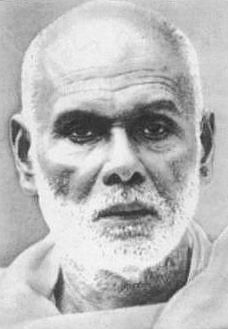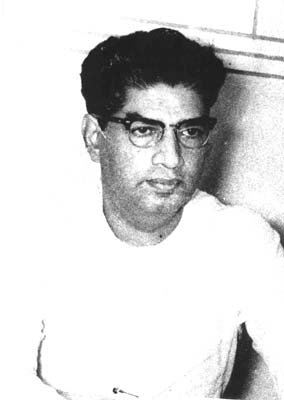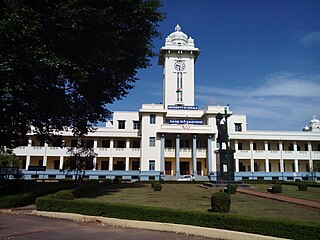
Sree Narayana Guru was a philosopher, spiritual leader and social reformer in India. He led a reform movement against the injustice in the caste-ridden society of Kerala in order to promote spiritual enlightenment and social equality. A quote of his that has become popular: "one caste, one religion, and one god for all men". He is the author of the Advaita poem Daiva Dasakam, which is one of the most used poem in Kerala for community prayer.

Mahakavi Kumaran Asan was a poet of Malayalam literature, Indian social reformer and a philosopher.He is known to have initiated a revolution in Malayalam poetry during the first quarter of the 20th century, transforming it from the metaphysical to the lyrical and his poetry is characterised by its moral and spiritual content, poetic concentration and dramatic contextualisation. He is one of the triumvirate poets of Kerala and a disciple of Sree Narayana Guru. He was awarded the prefix "Mahakavi" in 1922 by the Madras university which means "great poet".
Secular National Dravida Party, was a political party in the Indian state of Kerala. The party was founded on 7 January 2004 by elements of the Ezhava caste organization Ezhava Mahajana Sabha. Founding chairman was S. Suvarnakumar. The party professed itself to 'Sreenarayanism', the teachings of Shree Narayana Guru. The party also demanded higher representation for the Ezhava caste in the political process.

Raman Sankar was an Indian politician, statesman, administrator,orator, educationist, writer and editor who served as the 3rd Chief Minister of Kerala from 1962 to 1964.

The Nair Service Society (NSS) is an organisation created for the social advancement and welfare of the Nair community that is found primarily in the state of Kerala in Southern part of India. It was established under the leadership of Mannathu Padmanaban. The NSS is a three-tier organisation with Karayogams at the base level, Taluk Unions at the intermediate level and a central headquarters operating from Perunna, Changanassery in Kerala. G. Sukumaran Nair is the present General Secretary.

C. Kesavan was a politician,freedom fighter,social reformer, statesman and the chief minister of Travancore-Cochin during 1950–1952. He led the Nivarthana agitation in Travancore to gain the democratic authority for the citizens to decide on the legislation and to attain opportunities regardless of caste or social and economical status.

Padmanabhan Palpu was a physician from the Kingdom of Travancore who served as a chief medical officer of Mysore State.

The Ezhavas are a community with origins in the region of India presently known as Kerala, where in the 2010s they constituted about 23% of the population and were reported to be the largest Hindu community. The Malabar Ezhava group have claimed a higher ranking in the Hindu caste system than do the others, although from the perspective of the colonial and subsequent administrations they were treated as being of similar rank.

Mooloor S. Padmanābha Panicker (1869-1931) was a poet and a prominent social reform activist from the Travancore region of present-day Kerala.

T. K. Madhavan Alias Deshabhimani Madhavan, was an Indian social reformer, journalist and revolutionary, who was involved with the Sree Narayana Dharma Paripalana Yogam. He hailed from Kerala and led the struggle against Social discrimination which was known as Vaikom Satyagraha.

The importance and antiquity of education in Kerala are underscored by the state's ranking as among the most literate in the country. The educational transformation of Kerala was triggered by the efforts of the Church Mission Society missionaries, who were the pioneers that promoted mass education in Kerala, in the early decades of the 19th century. The local dynastic precursors of modern-day Kerala—primarily the Travancore Royal Family, the Nair Service Society, Sree Narayana Dharma Paripalana Yogam and Muslim Educational Society (MES)—also made significant contribution to the progress on education in Kerala. Local schools were known by the general word kalaris, some of which taught martial arts, but other village schools run by Ezhuthachans were for imparting general education. Christian missionaries and British rule brought the modern school education system to Kerala. Ezhuthu palli was the name used in earlier times. The word was derived from the schools run by the Buddhist monasteries. For centuries villages used to set up an ezhuthupally or ashan pallikoodam with one or two teachers. Students used to go this school from nearby areas and learn languages, literature, mathematics, grammar etc. After completing this students may continue study about specific subjects such as ayurveda, astrology, accounting etc. Censuses during 1800 shows that Travancore, Cochin, Kannur areas have many such schools. Even name list of ashans were used to be published along with the census.

The Sree Narayana Dharma Paripalana Yogam (S.N.D.P) is a social service organization that has been representing the Ezhava community from the Indian state of Kerala since 1903.

Advaita Ashram - the ashrams in Aluva, founded in 1913 Sree Narayana Guru. Here he also established a Sanskrit school to restore the sanctity of the language through which universal spiritual teachings can be grasped and imparted to dedicated disciples.
Changaramkumarath Krishnan Vakkeel was a community leader, banker, social reformer, and journalist from Kerala, India. He was a champion of implementing the revolutionary socialist reforms proposed by Sree Narayana Guru for the upliftment of the downtrodden people of Kerala. He was called Mithavathi―a minimalist―after the newspaper he published from 1913 to 1938 to spread the message of the reformist movement. He was well-educated and hailed from an influential family. Although he could have entered the government service and risen to higher positions with his education and wealth, he renounced all these for the liberation of the backward classes from the clutch of pathological social system.
Hindu Matha Dharma Paripalana (HMDP) Sabha, Moothakunnam, Ernakulam was established in 1882 under the guidance of Asthavadhani Parishudha Vishista Paranatha Khanadana Venkatagiri Sasthrikal, an Andhrite theologist. He was the founder president of HMDP Sabha. Erezhath U Krishnan Vaidyan, Srimoolam Praja Sabha member, as founder secretary, motivated by the teachings of Sree Narayana Guru.
Mannanthala Anandavalleshwaram Devi Temple is a Hindu temple in the Mannanthala suburb of Thiruvananthapuram, India.
The SAS SNDP Yogam College is the first college in Konni, Kerala, India. It was started by the Sree Narayana Dharma Paripalana Yogam (SNDP), in 1995. Resolved to establish a college at Konni in Memorial obeisance to the great philosopher and social reformer, Sahodaran Ayyappan, an ardent disciple of Sree Narayana Guru to provide better, higher educational facilities mainly for the backward classes of the region.
Sree Narayana Polytechnic College (Malayalam: ശ്രീ നാരായണ പോളിടെക് നിക്ക് is located in Kottiyam near Kollam, Kerala in southern India. It is named after the Saint and social reformer "Sree Narayana Guru". SNPTC was founded in 1957, by the Sree Narayana Trusts, Kollam under the initiative of the secretary, the late Sri.R.Sankar, former chief minister of Kerala. In the period 2006–07, the college celebrated its Golden Jubilee.
Kollam district, earlier called Quilon district, is one of the 14 districts of Kerala state, India. The district is representative of all the natural attributes of Kerala states, and is endowed with a long coastal region, a major sea port on the Arabian Sea, plains and the mountains, lakes, lagoons and Kerala Backwaters, forests and the farm land, and rivers and streams. The area had mercantile relationship with Phoenicians and the Romans.












